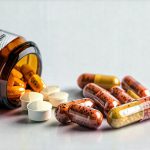Antibiotics are powerful medications crucial for fighting bacterial infections, but their broad-spectrum nature—killing both harmful and beneficial bacteria—often disrupts the delicate ecosystem within our gut. This disruption is a primary reason many people experience digestive sensitivities after completing a course of antibiotics. These sensitivities can range from mild discomfort like bloating and gas to more significant issues such as diarrhea, constipation, or even nausea. Understanding why this happens and proactively supporting your gut health during and after antibiotic use are vital steps towards minimizing these unpleasant side effects and restoring optimal digestive function. It’s important to remember that everyone reacts differently; the severity and duration of digestive sensitivity will vary depending on factors like the type of antibiotic used, dosage, individual gut microbiome composition, and overall health status.
The gut microbiome is incredibly complex – a vast community of trillions of microorganisms, including bacteria, fungi, viruses, and other microbes residing in our digestive tract. This ecosystem plays a critical role not only in digestion but also in immune function, nutrient absorption, and even mental wellbeing. Antibiotics, while targeting harmful bacteria causing infection, inadvertently impact this delicate balance. Their indiscriminate killing action reduces microbial diversity, potentially leading to an overgrowth of less desirable organisms, like opportunistic pathogens, further exacerbating digestive issues. Recognizing this imbalance is the first step towards recovery, and there are numerous strategies you can employ to support your gut’s natural healing process. If you’re experiencing lingering effects after illness, explore how digestive sluggishness may be contributing.
Understanding the Gut-Antibiotic Connection
The core issue behind post-antibiotic digestive sensitivity lies in the disruption of the gut microbiome’s delicate equilibrium. Antibiotics don’t distinguish between ‘good’ and ‘bad’ bacteria; they target a broad range, leading to a decrease in beneficial bacterial populations. This reduction can have several cascading effects: – Reduced capacity for food digestion: Certain bacteria are crucial for breaking down complex carbohydrates and fibers. Their absence leads to undigested food fermenting in the gut, causing gas, bloating, and discomfort. – Impaired nutrient absorption: A healthy microbiome aids in absorbing vital nutrients from food. Its disruption can lead to deficiencies even with adequate dietary intake. – Increased susceptibility to opportunistic pathogens: With fewer beneficial bacteria present, harmful organisms like Clostridioides difficile (C. diff) can proliferate, causing severe diarrhea and colitis. – Compromised immune function: Approximately 70-80% of the immune system resides in the gut. A disrupted microbiome weakens immune defenses, making you more vulnerable to infections. The duration of these effects depends on several factors, including the specific antibiotic used, its length of administration, and the individual’s pre-existing gut health. Some individuals experience a relatively quick recovery as their beneficial bacteria repopulate naturally, while others may struggle with lingering digestive issues for weeks or even months. If you are looking to rebuild your microbiome, there are specific steps you can take.
This imbalance isn’t just about bacterial numbers; it’s also about diversity. A diverse microbiome is a resilient one, capable of adapting to changes and resisting the colonization of harmful organisms. Antibiotics often reduce this diversity significantly, creating a less stable environment within the gut. Think of it like a forest ecosystem – a diverse forest with many different tree species is more resistant to disease than a monoculture plantation. Restoring microbial diversity is therefore key to long-term digestive health and overall wellbeing. Furthermore, the impact extends beyond just the intestines; the gut microbiome influences other systems in the body through the gut-brain axis, impacting mood, cognitive function, and even sleep quality. Digestive issues can also arise from drastic dietary changes.
Rebuilding Your Gut Health: Dietary & Lifestyle Strategies
Rebuilding a healthy gut after antibiotics is a gradual process that requires a multifaceted approach centered around diet and lifestyle adjustments. It’s not about quick fixes but rather consistent efforts to support the natural healing processes of your digestive system. A cornerstone of this recovery is incorporating prebiotic foods into your diet. Prebiotics are types of fiber that act as food for beneficial bacteria, encouraging their growth and proliferation. Excellent sources include: – Onions & garlic – Leeks – Asparagus – Bananas (slightly green) – Oats – Apples – Chicory root Alongside prebiotics, probiotic-rich foods can also be helpful. Probiotics are live microorganisms that directly contribute to the gut microbiome. Fermented foods like yogurt (with live and active cultures), kefir, sauerkraut, kimchi, and kombucha are excellent sources. However, it’s important to note that probiotic supplements aren’t always necessary or beneficial for everyone, and it’s best to consult with a healthcare professional before starting supplementation.
Beyond diet, lifestyle factors play a crucial role in gut health restoration. Stress management is paramount, as chronic stress can negatively impact the microbiome. Techniques like meditation, yoga, deep breathing exercises, and spending time in nature can help mitigate stress levels. Adequate sleep (7-9 hours per night) is also essential for overall wellbeing and supports gut function. Finally, staying hydrated by drinking plenty of water helps maintain a healthy digestive system and facilitates nutrient absorption. Prioritizing these lifestyle changes alongside dietary adjustments sets the stage for long-term gut health and resilience. If you struggle to find relief after heavy meals, consider how to ease symptoms .
Supporting Digestion During Antibiotic Use
Even during antibiotic treatment, you can take steps to minimize digestive upset and support your gut. – Timing is key: If possible, take antibiotics with food to help reduce stomach irritation. However, some antibiotics have specific instructions regarding whether they should be taken with or without food – always follow your doctor’s recommendations. – Stay hydrated: Drink plenty of water throughout the day to prevent dehydration and aid in digestion. – Focus on easily digestible foods: Opt for bland, low-fiber foods like rice, toast, bananas, and applesauce (the BRAT diet) if you experience diarrhea. Avoid greasy, spicy, or heavily processed foods that can further irritate your digestive system. – Consider a temporary probiotic supplement (with healthcare provider guidance): Some studies suggest that taking a probiotic during antibiotic treatment may help mitigate the negative impact on the microbiome. However, it’s crucial to choose a strain appropriate for your needs and consult with a healthcare professional before starting supplementation. It’s also important to separate the probiotic dose from the antibiotic dose by at least 2 hours to avoid inactivation.
Addressing Specific Symptoms
Different individuals may experience different digestive symptoms after antibiotics. Here’s how to approach some common issues: – Diarrhea: Beyond the BRAT diet, consider incorporating foods rich in binding agents like pectin (applesauce) or psyllium husk to help solidify stools. Avoid dairy products, caffeine, and alcohol, as these can exacerbate diarrhea. – Constipation: Increase your fiber intake gradually with sources like oats, flaxseeds, and chia seeds. Drink plenty of water and engage in regular physical activity to stimulate bowel movements. – Bloating & Gas: Identify potential trigger foods (like cruciferous vegetables, beans, or carbonated beverages) and limit their consumption. Consider incorporating digestive enzymes to aid in food breakdown. – Nausea: Sip on ginger tea or peppermint tea, both of which have anti-nausea properties. Eat small, frequent meals rather than large ones. Digestive sensitivity can also be triggered by external factors.
Long-Term Gut Health Maintenance
Once your immediate post-antibiotic symptoms subside, it’s essential to maintain long-term gut health. This involves continuing the dietary and lifestyle strategies mentioned earlier: – Prioritize a diverse diet rich in prebiotics and probiotics. – Manage stress effectively through techniques like meditation or yoga. – Ensure adequate sleep (7-9 hours per night). – Stay hydrated by drinking plenty of water. – Consider periodic probiotic supplementation if recommended by your healthcare provider, especially during times of stress or illness. – Limit processed foods, sugar, and artificial sweeteners, as these can negatively impact the microbiome. Investing in your gut health is an investment in your overall wellbeing. A resilient gut microbiome not only supports optimal digestion but also strengthens your immune system and contributes to a healthier, happier you. It’s about creating sustainable habits that promote long-term health rather than seeking quick fixes or relying solely on supplements. If digestive stress increases during the holidays, remember how to reduce stress. Also, understanding flare ups can help you prepare for and manage digestive distress.


















